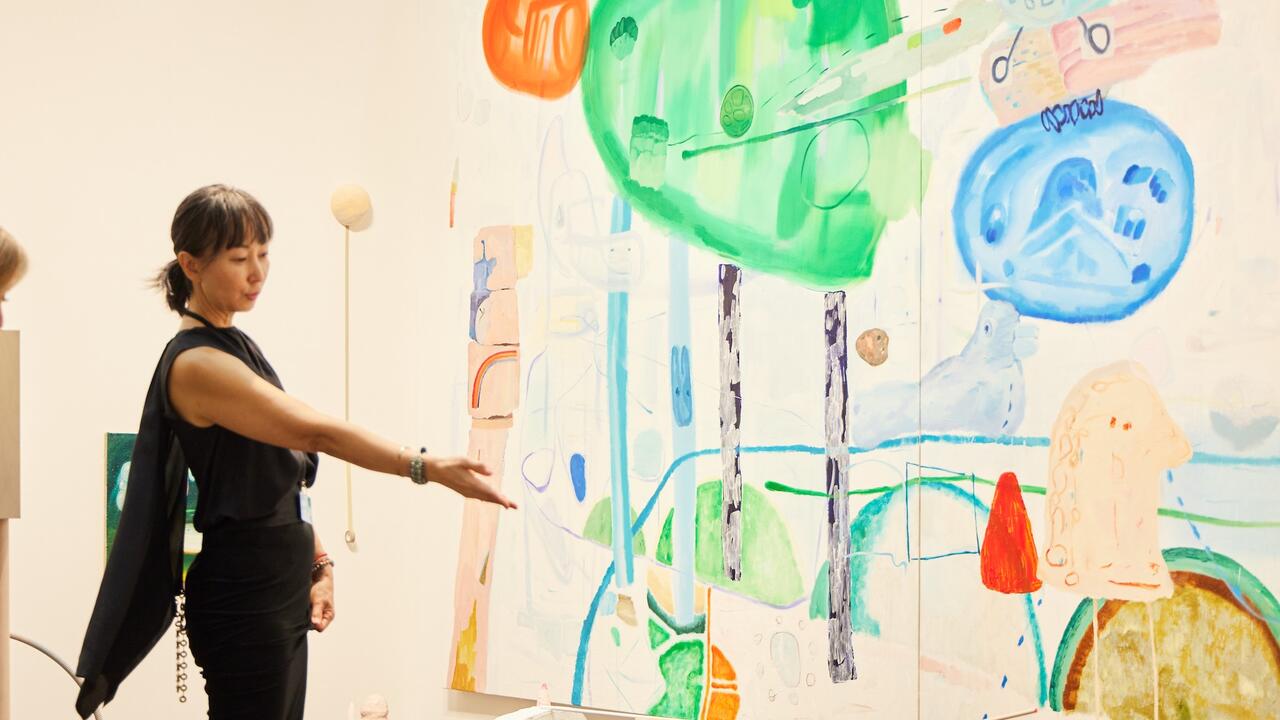Alexandre Joly
Kunsthaus Langenthal
Kunsthaus Langenthal

The receptionist wore a toothy grin. Pushing aside the synthetic, powder-blue curtains covering the entrance to Swiss artist Alexandre Joly’s exhibition Silent Movements you found yourself in a corridor lined on both sides with the same blue stuff, while the thing smirked at you from one end. It was La Masque, (The Mask, 2012) a large, tawny ceramic turtle shell affixed to the wall, its mouth stuffed with fat horse teeth, with two slit-like eyes. The face suggested exoticism and maybe unpredictable savagery, but its cheesy expression told us not to approach the show too earnestly.
The first impression was not only visual and haptic, but auditory too (despite the title). Beats and murmurs emerged from several adjoining rooms. The most insistent of these was from Radars (2012), three knee-high platforms installed in separate small, darkened galleries. Above these a small microphone spun in swift circles around a vertical axis generating a dull thump each time it passed through a magnetic field, while lights on the platforms strobed, refracted by large crystals and the mechanism’s own movement. An investigation of sound in the style of Cevdet Erek, whose installations of the same concerns are all thoroughly controlled, or Haroon Mirza’s clean laboratory style, would not be at home here. Joly’s assemblages were instead unruly, organic and, in the case of Radars, haphazard. Other works were a little more disciplined, like Les montagnes silencieuses (The silent mountains, 2013), a bed of white gravel raked around two mounds of spherical brass bells. Magnets within held the bells in place, so those instruments worn on winter sleighs or the heels of Morris dancers are stifled to become the focus of a Zen-style garden. An ornate, wood-panelled gallery housed Absolute Sine (2012), a shallow, circular pond with a slated edging. The black dyed water reflected the ceiling decoration, while inaudible frequencies being fed into the structure transformed its smooth surface into low ripples, casting a series of crystalline shadows.
At the other end of the corridor in another room was La Grande Réunion (The Big Gathering, 2013), a thicket of simple, tree-like Styrofoam forms with scalloped edges, variously coloured and coated. In a central clearing a miniature tree form was perched on a rough-hewn wooden base covered in brass disk piezoelectric speakers that emitted a further low drone. Across the corridor, a final gallery was home to Toupies (Tops, 2013), three large cymbals skewered on turned wooden poles to make giant spinning tops, six rattan children’s chairs arranged around them and two Shruti boxes (an electronic imitation of a bellows-activated instrument) filling the air with synthetic A and E tones – a perfect fifth. Untitled drawings on paper from 2013 were dotted throughout the many rooms: most of these featured multitudes of jagged edged trees.
Joly has an awareness of the physics of sound – its shapes are echoed in repeated patterns found in his drawings and he has made physics a theme in Absolute Sine – but he is more interested in sound’s social and cultural facets. Not in the respectful pursuit of universal truths – instead, Joly selects his multicultural tropes in an irreverent, à la carte fashion. The tinny noises that come from the Shruti boxes, combined with the immobile tops, may be a mockery of esoteric ideas of equilibrium or Karma. Les montagnes silencieuses has an air of solemn Monty Pythonesque absurdity – bells designed to be determinedly cheerful struck dumb by metallic attraction. And while some more rigour could have been brought to bear on his installations, you can’t knock his glee and humour, as he gathers tropes like a tourist in a souk grabbing trinkets.













